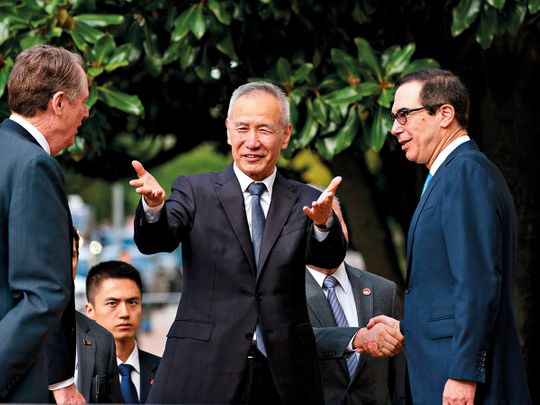
New York: Stock traders were cautiously optimistic monitoring the latest trade developments as a long-anticipated meeting between America and China got underway, and after contrasting reports on the talks spurred volatility. Treasury yields rose.
Banks and automakers led the S&P 500 index higher, with an extra boost after President Donald Trump confirmed talks will continue on Friday, after a wild overnight session that saw futures whipsawed by headlines giving conflicting signs of progress on the negotiations. The dollar fell, brushing off a weak inflation reading as all eyes remained on trade.
US stocks rose on Thursday after President Donald Trump confirmed he would meet Chinese Vice Premier Liu He on Friday for further trade talks, adding to optimism following a report that China was willing to reach a deal.
In the morning trade the Dow Jones Industrial Average was up 152.65 points, or 0.58 per cent, at 26,498.66, while the S&P 500 was up 16.28 points, or 0.56 per cent, at 2,935.68. The Nasdaq Composite was up 49.44 points, or 0.63 per cent, at 7,953.18.
Trump confirmed the two sides will be meeting again on Friday. South China Morning Post had reported earlier that the Chinese delegation, headed by Liu He, planned to leave Washington on Thursday.
Separately, Liu He said Beijing was willing to reach an agreement with Washington to prevent any further escalation in the trade war, Chinese state news agency Xinhua reported
Markets have grown jittery against a backdrop of deteriorating economic data and fresh tensions between the US and China in recent days, as they prepare for the first face-to-face talks between senior officials since July. Investor nerves were on full display Thursday as a series of headlines roiled markets, with traders attempting to digest reports on everything from the duration of the talks to the potential currency pact.
“China trade talks are really dominating everything and we’ve seen how unpredictable they can be,” Chris Gaffney, president of world markets at TIAA, said by phone. “We’ve seen it move just back and forth so dramatically. I think everyone’s really going to have to wait until a deal gets actually done.”
Elsewhere on Thursday, the Stoxx Europe 600 Index rose slightly. Asian shares ended the session mixed, with Japanese equities recouping their declines by the close, South Korea down and Hong Kong and Shanghai notching modest gains.
Oil prices rise as Opec pledges decision on supply
Brent and WTI futures up Opec signals supply decision for 2020
London: Oil prices rose on Thursday as Opec indicated that all options were on the table to balance oil markets and that it would take a decision in December on supply for next year.
Mohammad Barkindo, leader of the exporter group, did not specify if the move would mean extending a pact to rein in production to stabilise prices, but the comments appeared to nudge the market out of pessimism over US-China trade talks.
Global benchmark Brent crude futures rose by 8 cents, or 0.14 per cent, to $58.40 a barrel at 1125 GMT. US West Texas Intermediate (WTI) futures were up 10 cents, or 0.19 per cent, at $52.69.
A December meeting between the Organization of the Petroleum Exporting Countries plus allies including Russia would take “decisions that will set us on the path of heightened and sustained stability for 2020”, Barkindo said on Thursday.
“Barkindo’s comment reminds markets that if oil prices do not fall off a cliff over demand concerns, we could very see Opec+ extend their production cuts throughout the majority of 2020,” said Edward Moya, senior market analyst at OANDA in New York.
Separately, Saudi Arabia told Opec its monthly oil output fell by 660,000 bpd in September after major attacks on its energy facilities, while Opec lowered its 2020 forecast for non-Opec supply growth.
Those signals from Opec suggested a tighter global oil supply picture, but elsewhere abundance reigned.
Price gains were curbed by a report of rising stockpiles in the United States, currently the world’s biggest oil producer.
US crude stocks rose by 2.9 million barrels in the week to October 4, the Energy Information Administration (EIA) said on Wednesday, more than double analyst expectations.












